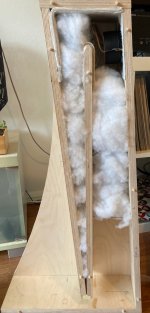My choice , final adjustments.
Minimal sound absorbers.
Dump-duct Area:91cm2(6.5x14cm) , Length:10cm
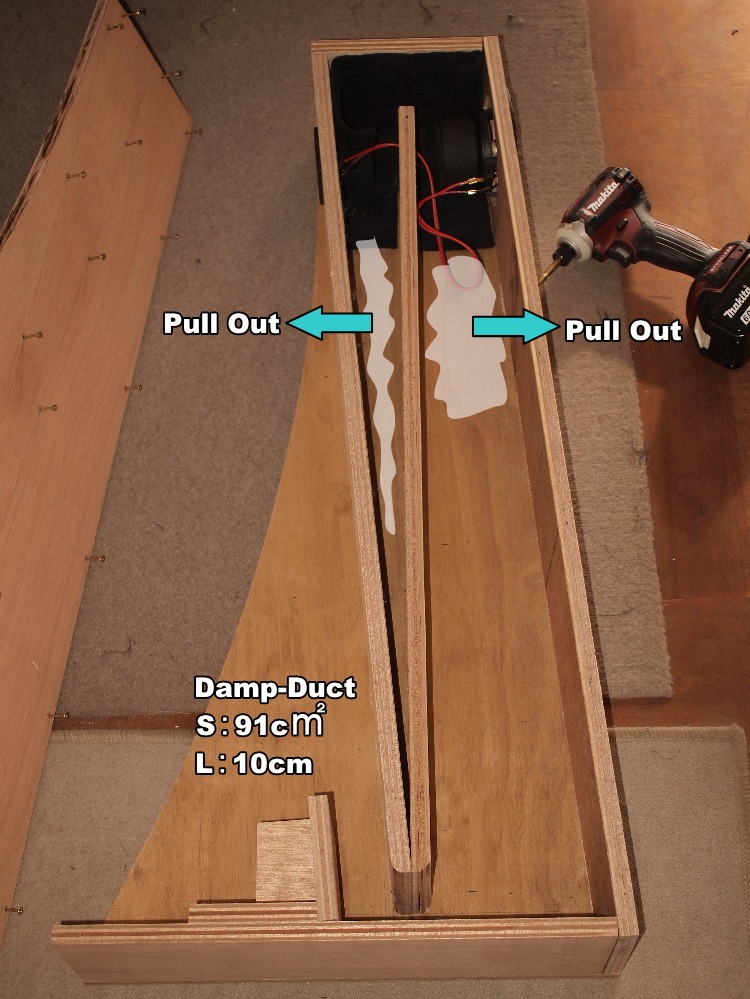
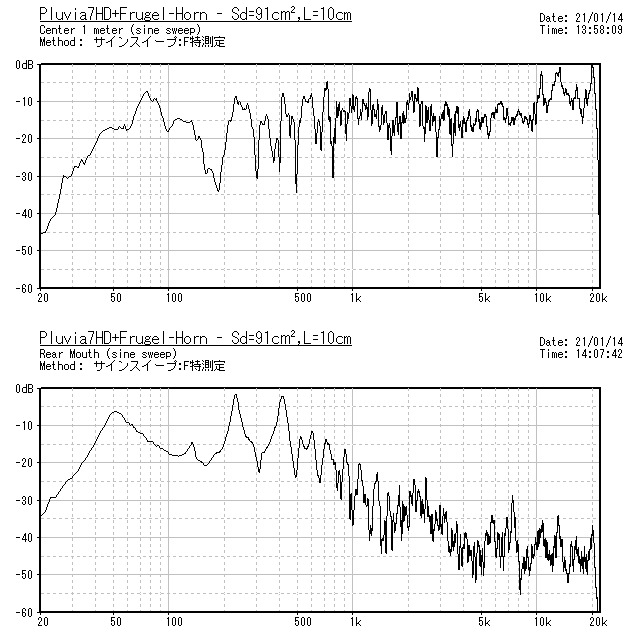
My FH mk3 is thunder and storm sounds.
7HD+Frugel Horn - Final adjustment version [ My Final Choice ]---------Damp-Duct (S:91cm2 , L:10cm) - YouTube
Minimal sound absorbers.
Dump-duct Area:91cm2(6.5x14cm) , Length:10cm


My FH mk3 is thunder and storm sounds.
7HD+Frugel Horn - Final adjustment version [ My Final Choice ]---------Damp-Duct (S:91cm2 , L:10cm) - YouTube
This is really interesting! Can someone please explain the thinking behind a ‘Damp duct’?
He's changed the internal low-pass choke into a duct to lower tuning. While it does achieve that, it also entails some compromises that haven't been mentioned and are somewhat at odds with the design goals, so it's not something I would recommend to others (while acknowledging that it suits nandappe).
The 2KHz aspect is either another minor difference from measurement setup (no criticism implied -you can get such changes through something as simple as different atmospheric conditions), or possibly from adjusting the damping & killing an internal reflection: the enclosure does not operate that high in terms of producing output, and FH3's damping scheme is designed to be user-adjustable.
Last edited:
Another Frugel-Horn Mk3 Birth Announcement
Holy heck. I’m smitten with these speakers. Thank you to those that contributed to the plan and development as well as the community posting on the various build threads. I’ve learned a ton and am enjoying the ride. For anyone thinking about crafting their own pair, I would say without hesitation to go for it. The payoff is huge.
I’m still certainly honeymooning here as I’ve only had these set up for four days. The first impression of my build: I’d say the bass is palatable and frankly, surprising. The mids are strong, and the top end is “getting there” - I think I need more testing with various amps available to see if I can get a bit more sparkle.
Amplification
I’m surprised how well the TubeCube|7 drives the Alpair 7MS in the Frugel-Horn Mk3 - the combination is IMO surprisingly good. It’s my current preference for an amp. Initially, I was worried it wouldn’t be a good match and simply be anemic. That little amp does wonders for my much more sensitive BiB speakers that I constructed last year... “but what about these FH3?” is all I kept thinking about while waiting for the glue to dry. Well, the answer is, astoundingly well, and “oh damn the bass!!!” The notion that these relatively small drivers can get down low with authority on a flea-watt amp is still astounding me. We’re not waking the neighbors here, but for comfortable listening at like 75 to 80ish db, it’s mmm so good. I’m keen to get an 8 to 10-watt EL34 valve amp to dedicate to these FH3s and learn if a little more muscle offers a bit more top-end sparkle. Admittedly, I’m not a high-frequency fiend, but I do feel it’s pretty rolled off on the top end. Perhaps I need to consider additional dampening to decrease the bass a bit?
Comparisons
Comparing these FH3s to my BiB units is interesting for me as they are both DIY builds that I’ve created and feature some specific similarities and differences. IMO I think the differences in character have the most to do with the high sensitivity of drivers in the BiB. In a way, I would characterize the BiB sound like a sizeable classical concert hall or church with a vast soundstage, while the FHmk3 is more of a thumping intimate small club sound. The BiB offers a more open and airy experience with the bass coming from a much larger place, wrapping around you, with aspects that are not as succinct or tight much like an organ in the balcony at church. The FHmk3 low-end offers a more familiar directional punch with definition, seemingly emanating from the whole front of the speaker.. just not rising up (obviously, I guess) like the BiB. When compared to my Ascend Acoustics CBM 170’s, they are actually similar in many ways, but not as thick or “wet” in the bass as those bookshelves with the 6.5” woofer. Over the years I’ve also garnered a few pairs of “respectable but cheap” mass-market speakers like the Pioneer SP-BS22-LR and Micca RB42 - and it’s not even close here, the Frugel-Horn Mk3 obliterates them in every possible way. Absolutely different leagues.
Anyway, here are some pics of my build. Materials included 1 sheet of basic 18mm plywood, a cotton bath mat for dampening, fiberfill, TiteBond II PVA, BIN primer, Benjamin Moore ‘Gibson Gold’, 5-way binding cups/posts, solder and 10g OFC wire, walnut veneer, and shellac.
My design/finishing was directly inspired by user bARTaudio and the post of his build.
The ‘monolith on a slant’ treatment just rings my bell. I feel it emphasizes the backward lean of the design which I think is quite striking and is instantly a visual cue as a differentiator from standard speaker boxes. The color in the rear - “Gibson Gold” was selected by my son who loves the color of a Gibson gold top I have and suggested it. I’m not sold on it for a speaker color, but whatever, it’s something different. The wood veneer is walnut with clear shellac finishing and came out quite good. All in all, I’m quite pleased with the overall look and even better, I LOVE the sound!
Holy heck. I’m smitten with these speakers. Thank you to those that contributed to the plan and development as well as the community posting on the various build threads. I’ve learned a ton and am enjoying the ride. For anyone thinking about crafting their own pair, I would say without hesitation to go for it. The payoff is huge.
I’m still certainly honeymooning here as I’ve only had these set up for four days. The first impression of my build: I’d say the bass is palatable and frankly, surprising. The mids are strong, and the top end is “getting there” - I think I need more testing with various amps available to see if I can get a bit more sparkle.
Amplification
I’m surprised how well the TubeCube|7 drives the Alpair 7MS in the Frugel-Horn Mk3 - the combination is IMO surprisingly good. It’s my current preference for an amp. Initially, I was worried it wouldn’t be a good match and simply be anemic. That little amp does wonders for my much more sensitive BiB speakers that I constructed last year... “but what about these FH3?” is all I kept thinking about while waiting for the glue to dry. Well, the answer is, astoundingly well, and “oh damn the bass!!!” The notion that these relatively small drivers can get down low with authority on a flea-watt amp is still astounding me. We’re not waking the neighbors here, but for comfortable listening at like 75 to 80ish db, it’s mmm so good. I’m keen to get an 8 to 10-watt EL34 valve amp to dedicate to these FH3s and learn if a little more muscle offers a bit more top-end sparkle. Admittedly, I’m not a high-frequency fiend, but I do feel it’s pretty rolled off on the top end. Perhaps I need to consider additional dampening to decrease the bass a bit?
Comparisons
Comparing these FH3s to my BiB units is interesting for me as they are both DIY builds that I’ve created and feature some specific similarities and differences. IMO I think the differences in character have the most to do with the high sensitivity of drivers in the BiB. In a way, I would characterize the BiB sound like a sizeable classical concert hall or church with a vast soundstage, while the FHmk3 is more of a thumping intimate small club sound. The BiB offers a more open and airy experience with the bass coming from a much larger place, wrapping around you, with aspects that are not as succinct or tight much like an organ in the balcony at church. The FHmk3 low-end offers a more familiar directional punch with definition, seemingly emanating from the whole front of the speaker.. just not rising up (obviously, I guess) like the BiB. When compared to my Ascend Acoustics CBM 170’s, they are actually similar in many ways, but not as thick or “wet” in the bass as those bookshelves with the 6.5” woofer. Over the years I’ve also garnered a few pairs of “respectable but cheap” mass-market speakers like the Pioneer SP-BS22-LR and Micca RB42 - and it’s not even close here, the Frugel-Horn Mk3 obliterates them in every possible way. Absolutely different leagues.
Anyway, here are some pics of my build. Materials included 1 sheet of basic 18mm plywood, a cotton bath mat for dampening, fiberfill, TiteBond II PVA, BIN primer, Benjamin Moore ‘Gibson Gold’, 5-way binding cups/posts, solder and 10g OFC wire, walnut veneer, and shellac.
My design/finishing was directly inspired by user bARTaudio and the post of his build.
The ‘monolith on a slant’ treatment just rings my bell. I feel it emphasizes the backward lean of the design which I think is quite striking and is instantly a visual cue as a differentiator from standard speaker boxes. The color in the rear - “Gibson Gold” was selected by my son who loves the color of a Gibson gold top I have and suggested it. I’m not sold on it for a speaker color, but whatever, it’s something different. The wood veneer is walnut with clear shellac finishing and came out quite good. All in all, I’m quite pleased with the overall look and even better, I LOVE the sound!
Attachments
-
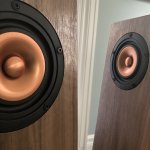 1_Easy-Resize.com.jpg823.9 KB · Views: 658
1_Easy-Resize.com.jpg823.9 KB · Views: 658 -
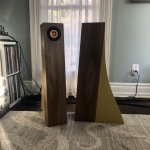 10_Easy-Resize.com.jpg914.7 KB · Views: 364
10_Easy-Resize.com.jpg914.7 KB · Views: 364 -
 9_Easy-Resize.com.jpg921.8 KB · Views: 349
9_Easy-Resize.com.jpg921.8 KB · Views: 349 -
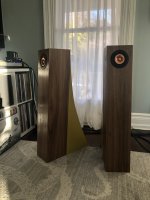 8_Easy-Resize.com.jpg692.8 KB · Views: 320
8_Easy-Resize.com.jpg692.8 KB · Views: 320 -
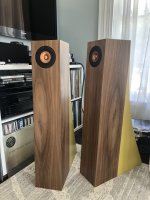 7_Easy-Resize.com.jpg697.8 KB · Views: 333
7_Easy-Resize.com.jpg697.8 KB · Views: 333 -
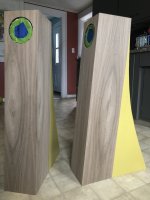 6_Easy-Resize.com.jpg671.2 KB · Views: 372
6_Easy-Resize.com.jpg671.2 KB · Views: 372 -
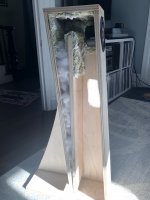 5_Easy-Resize.com.jpg581.6 KB · Views: 429
5_Easy-Resize.com.jpg581.6 KB · Views: 429 -
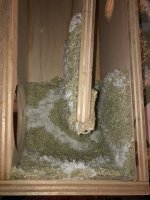 4_Easy-Resize.com.jpg841 KB · Views: 395
4_Easy-Resize.com.jpg841 KB · Views: 395 -
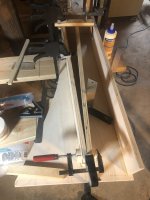 3_Easy-Resize.com.jpg734.3 KB · Views: 621
3_Easy-Resize.com.jpg734.3 KB · Views: 621 -
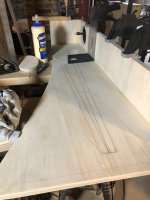 2_Easy-Resize.com.jpg760.8 KB · Views: 662
2_Easy-Resize.com.jpg760.8 KB · Views: 662
Notice to future weary forum surfers who've built FH MK3s using the Alpair 7MS drivers and are looking to tame the low end - see pic attached for where I ended up on polyfill. I didn't weigh it but I used a good chunk of the 1kg bag... maybe ~130g per cabinet. I'm using a Yamaha A-S301 amp so YMMV.
I also got these Acousti Feet in 20° Shore for an inexpensive isolation solution which tidied up the lows even further (this probably has more to do with the floor material of my apartment, though). They were only aud$33 for a set of 8 on eBay so definitely worth it if you live in a 60s era Australian mid-sized apartment block with original cheap floor boards 😀
Hang in there on break in too. Mark Audio quotes 10hrs but mine are still getting better after 30+hrs.
I also got these Acousti Feet in 20° Shore for an inexpensive isolation solution which tidied up the lows even further (this probably has more to do with the floor material of my apartment, though). They were only aud$33 for a set of 8 on eBay so definitely worth it if you live in a 60s era Australian mid-sized apartment block with original cheap floor boards 😀
Hang in there on break in too. Mark Audio quotes 10hrs but mine are still getting better after 30+hrs.
Attachments
Last edited:
He's changed the internal low-pass choke into a duct to lower tuning. While it does achieve that, it also entails some compromises that haven't been mentioned and are somewhat at odds with the design goals, so it's not something I would recommend to others (while acknowledging that it suits nandappe).
Hi Scott,
Could you please share more details of this attachment, its advantages and disadvantages. didn't seen it earlier .
To be honest it's nothing to do with me and I do not recommend it since it does not appear to be in line with the design objectives, so it's probably best for the gentleman to explain it himself. It does force a lower tuning -but that wasn't the target goal of FH3 (the opposite actually) and it alters the wave expansion (FH3 was not designed purely with the 1d wave equation) which is a part of how it sounds / behaves the way it does. So while I have never pretended FH3 is in any way perfect, it's not a change I'd make myself, and to be honest, based on the feedback over the last decade or more, I think we got the balance of compromises right for the type of speaker it is supposed to be.
Which isn't to say I'm resistant to change / don't listen. If people want a small[ish] horn that targets a lower tuning than FH3, then Dave, ChrisB and I are perfectly happy to create one which we'll design for that object from the outset; that way we'll reduce the compromises in altering an existing design and might potentially be able to make some overall size etc. adjustments. However, if we do so, it would need to be for a specific drive unit as some of the flexibility of FH3 in accepting a range of units will be sacrificed to get that lower tuning.
Which isn't to say I'm resistant to change / don't listen. If people want a small[ish] horn that targets a lower tuning than FH3, then Dave, ChrisB and I are perfectly happy to create one which we'll design for that object from the outset; that way we'll reduce the compromises in altering an existing design and might potentially be able to make some overall size etc. adjustments. However, if we do so, it would need to be for a specific drive unit as some of the flexibility of FH3 in accepting a range of units will be sacrificed to get that lower tuning.
I love the damp-duct moreover it could be a great tuning tool with both placement and shape/size/angle and it’s easily removable. Does it have as much effect on the sound as stuffing? More? Does extending the horn section give us an opportunity to use a bigger driver with going to the XL? It seems to me it has potential upside without potential drawbacks (don’t like it? take it out). Is it a compromise to the design, sure, to the sound? Not so fast, it could be a benefit to the sound depending on duct size, shape, placement, driver, goals, room specifics, etc...
Note: it seems damped duct is the same as mass loading.
Tapered Wave Tube with Damp-Duct (TWTD) + Pluvia7HD
dave
Tapered Wave Tube with Damp-Duct (TWTD) + Pluvia7HD
dave
It is mass loading. Period. Unfortunately, in this instance it's mass loading in the wrong place to avoid problems (I know, I looked at it out of interest a decade ago when I had an idle moment).
I'm not sure I follow the query regarding 'extending the horn section', since there are no horn sections in FH3; it's a tapped horn (aka chamberless horn or Voigt horn if you prefer) with a hypex expansion profile and a brief restriction at a fixed point along the expansion to provide a low-pass filter -a technique pioneered by Olson but often overlooked. The size of drive unit that can be used is limited by both its physical width, and the total horn size since most larger units tend to need a larger horn, especially if you're trying to take them low or you will simply end up with a chronic lack of gain. That was one of the problems in the original FH & the Buschorn it was based on.
I'm not sure I follow the query regarding 'extending the horn section', since there are no horn sections in FH3; it's a tapped horn (aka chamberless horn or Voigt horn if you prefer) with a hypex expansion profile and a brief restriction at a fixed point along the expansion to provide a low-pass filter -a technique pioneered by Olson but often overlooked. The size of drive unit that can be used is limited by both its physical width, and the total horn size since most larger units tend to need a larger horn, especially if you're trying to take them low or you will simply end up with a chronic lack of gain. That was one of the problems in the original FH & the Buschorn it was based on.
Last edited:
Has anyone done an FHMK3 build using the Mark Audio MAOP 7 driver? I’m fairly satisfied with the Alpair 7MS, but hey... it’s the same mounting pattern... let’s chase the dragon if it’s easy!
I’m also interested in amplification options - my Yamaha A-S301 is totally overkill in terms of power and isn’t exactly what you’d consider high end... I do love it’s I/O configuration and remote capability though. Listening to other very good speakers and hearing the difference between amps has made me quite curious, especially if I was to move to the MAOP 7.
I’m also interested in amplification options - my Yamaha A-S301 is totally overkill in terms of power and isn’t exactly what you’d consider high end... I do love it’s I/O configuration and remote capability though. Listening to other very good speakers and hearing the difference between amps has made me quite curious, especially if I was to move to the MAOP 7.
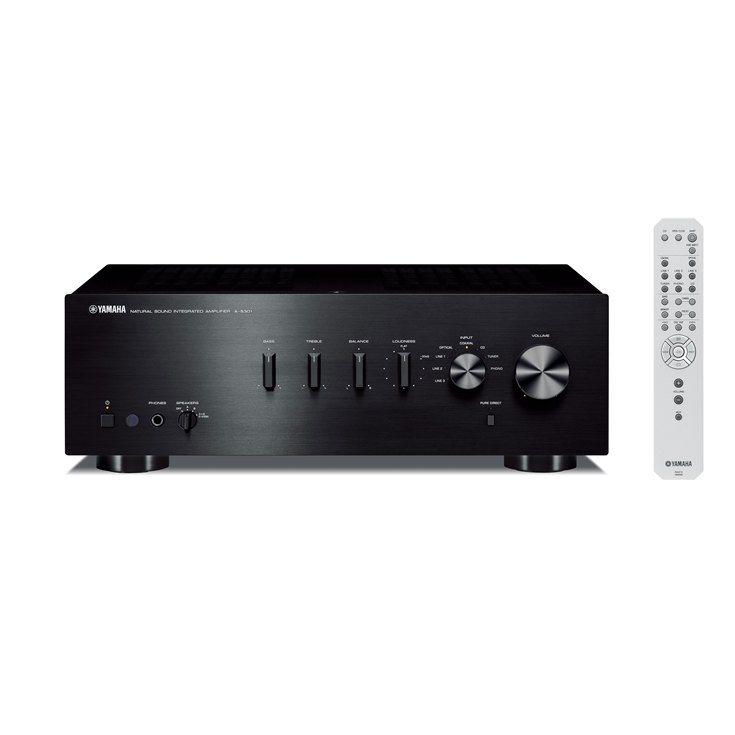
I love the looks of the amp.
Heatsinks look like they could support a small class A… or add a pre-amp out for a start.
The whole thing costs about what an ACA kit does.
dave
Has anyone done an FHMK3 build using the Mark Audio MAOP 7 driver? I’m fairly satisfied with the Alpair 7MS, but hey... it’s the same mounting pattern... let’s chase the dragon if it’s easy!
7.
I sold a kit to someone in Brooklyn for the MAOP7 and he is very happy with them. But he really can’t compare them to anything else. Unfortunately I wasn’t able to listen to them.
I love the looks of the amp.
Heatsinks look like they could support a small class A… or add a pre-amp out for a start.
The whole thing costs about what an ACA kit does.
dave
I love the look too! It's a great value option. One interesting thing I've found is using the 'direct' mode which skips the buffer amp/loudness/tone circuit sounds terrible. Loudness set at -15dB (out of flat to -30) and tone controls untouched is the sweet spot; sound gets kind of muddled and unbalanced either side.
Anyway, with my current level of understanding and exposure to how amps can effect sound this doesn't seem ideal and/or makes me feel like some performance is being left on the table, especially if I was to go to higher performance drivers. I am also curious to try the amp with other speakers to see if the same effect described above is reproducible. but I bought it to pair with the FHs which ended up being good for the price.
I also just think about this stuff constantly and am looking for excuses to upgrade (grey drivers would also look better with my cabinets) 😀
Last edited:
Be sure to acquire a good stock of Dramamine before you jump on board the upgrade of the month carousel to chase the brass ring of audio nirvana - or is it actually more of a temporary state of satori?
I still remember quite fondly my Yammies from the mid ‘70s; CA1000/CT800 and CR1000 - more than sufficient power for Dahlquist DQ10 in my small room, and I always thought that variable loudness control was brilliant.
I still remember quite fondly my Yammies from the mid ‘70s; CA1000/CT800 and CR1000 - more than sufficient power for Dahlquist DQ10 in my small room, and I always thought that variable loudness control was brilliant.
... this doesn't seem ideal and/or makes me feel like some performance is being left on the table...
There certainly is.
dave
Yes, it will audibly effect tuning / load behaviour & sound. The curved back / termini is not cosmetic.
- Home
- Loudspeakers
- Full Range
- Frugel-Horn Mk3 Builds & Build Questions
